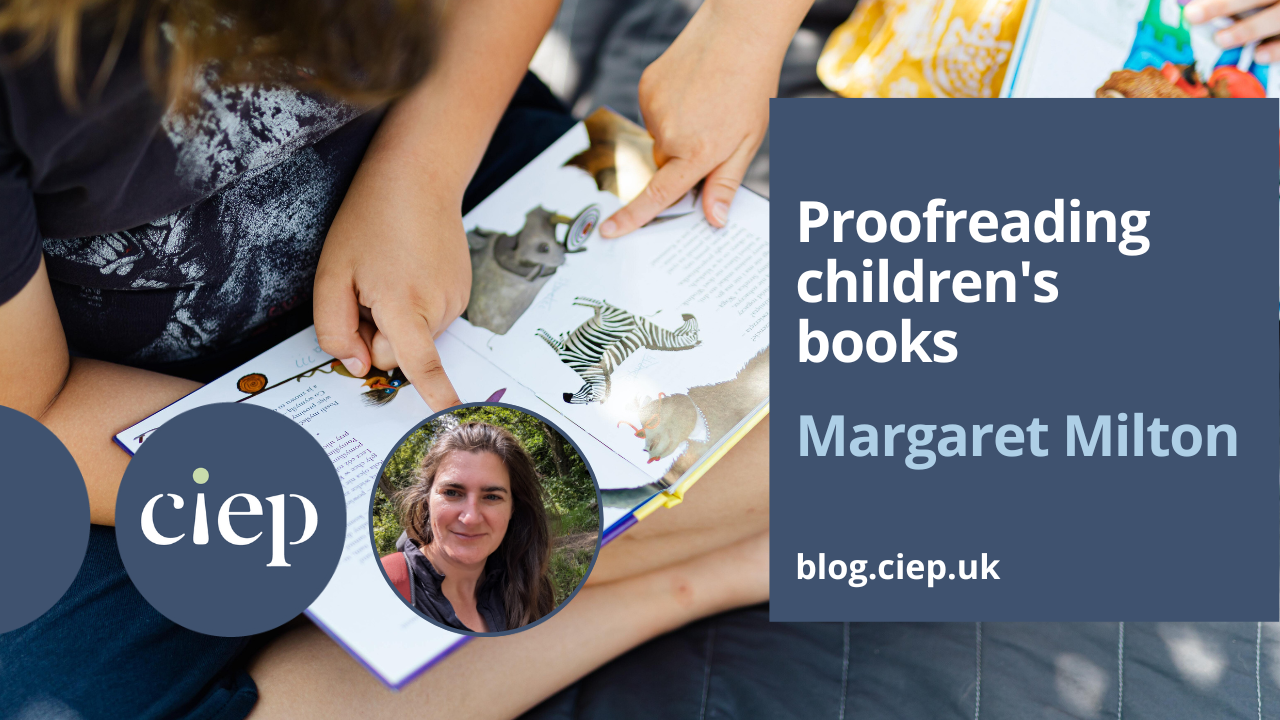Children’s books are simpler than adult’s books so they’re easier to proofread, right? Well, no – in some cases, as Margaret Milton explains, they’re much more complicated because there is so much to consider.
When family, friends, parents on the school run or indeed other CIEP members ask me what I’ve been working on this week and I say that I’ve been doing crosswords, or counting stickers in an activity book, or reading a picture book, they often look at me with confusion and sometimes a little bit of envy. When I started out in publishing, I didn’t really have an idea of the type of editing I wanted to do. I had initially trained as a primary teacher so, in the end, it made sense that I wound up editing children’s non-fiction and educational texts. From the outside, it may seem like a bit of a skive; however, there’s a lot more to it than one might think.
Words, words, words (or not!)
With children’s books (fiction and non-fiction), there are often few words, but this is usually the very thing that can trip an editor up. You need to read, read and read again. I personally also like to strip the text out of the file sent by the publisher (usually a PDF) and put it into a Word file, then run a spelling and grammar check. This gives me an extra assurance other than my own proofreading.
Also, in lots of these types of books, there are words set in a decorative font. These should be triple-checked as this is often where spelling mistakes are made. This is especially true if the words have been illustrated rather than typed because they can be misspelled, or the original word from the manuscript can be left in as well as the illustrated word inserted.
It can be assumed (unless the brief informs you otherwise) that the copyeditor has assessed the text to ensure that the level of language is suitable for the target age range and also checked the factual information. However, if something does strike you as overly complicated/too simplistic/factually incorrect, then mark it up. Better to be over-cautious than not.
A picture paints a thousand words
If you have been tasked with proofreading illustrated books, there are certain things that you will be expected to check. One of the main ones will be reviewing the illustrations alongside the text.
By proofreading stage, the illustrations will have mostly been signed off by the designer and the in-house editor. However, the proofreader will be expected to mark up discrepancies, for example if the text reads that the girl held a silver cup in her hand, but the illustrator has coloured it gold. In cases like this, it will be up to the in-house team to decide whether to change the text or have the illustration re-coloured.
The proofreader will also be expected to review the readability of the text against the illustrations. It’s often too late for a font style to be changed, but should you feel that words will be difficult to read (for example on a dark sky background), then you can mark this for the designer. You should also mark up where words overlap illustrations or if there is an obvious gap, as text may have fallen out of a text box in the InDesign file or disappeared during conversion to PDF.
In slightly more complicated non-fiction and educational books, the proofreader will need to review photographs alongside the text, asking questions such as ‘Does the image suitably relate to the text?’, ‘Does it convey what the text is explaining?’ and (an especially important one for educational books) ‘Is there a suitably diverse range of genders, ethnicities, abilities and so on?’
Flapping about
Paper-engineered books (books with flaps, pull-out sections etc) are often tricky, as the flap or pull-out is presented to you on a separate page from the page it will be stuck to. Therefore, you will need to marry the two up and ensure that what’s on the front of the flap aligns with what will be under it. As it is two-dimensional, it is sometimes difficult to picture what goes where, especially in large, non-fiction titles with multiple pull-out and lift-up sections. Publishers will not expect you to print out the pages but on the odd occasion it might be helpful to do this if you are finding it difficult to visualise. A second screen can also be helpful in matching up the various engineered elements to their final locations.
Fancy doing some origami?
Activity books may seem, in principle, like a great fun editing job – and a lot of the time they are. However, there is a huge number of elements that need to be checked to ensure that the activities work and children (and adults) won’t get frustrated. (We’ve all been there, where there’s a piece missing or there’s no actual way out of a maze!)
The proofreader must do all the activities to ensure they work. Ask questions such as:
- ‘Do all the answers to the crossword fit the boxes?’
- ‘Are all the words present in the wordsearch (and have any naughty words crept in by mistake when it was generated)?’
- ‘Are there spots to place the stickers and are the stickers all on the corresponding sticker sheet?’
- ‘Are there definitely six differences between the two images in spot the difference?’
- ‘Do the origami instructions work?’
… and so on.
Think about time management
A children’s picture book or lift-the-flap book may only have 10–50 words so it would only take about 10 minutes to read. However, the amount of time needed to check the varying elements should be taken into consideration. An activity book might only have a few hundred words, but once the proofreader has checked that every activity works and everything is in place then this will increase the proofreading time estimate.
For the most part, publishers will set their own rate for proofreading work but if you are quoting for a job yourself then don’t work simply from the word count!
Time management is also important regarding how you spread your work out across a week. For example, you may wish to read a picture book two or three times, but over a few days in order to have a slightly fresher eye each time.
Finally, don’t forget the basics!
Checking that activities work and the paper-engineered sections are correct is important, but obviously shouldn’t be to the detriment of checking the basics. Things that so commonly cause problems such as headers, footers, page numbers, copyright information, author and illustrator names, and the title should all be factored into the proofreading time and given as much importance as the ‘fancy stuff’!
About Margaret Milton
Margaret Milton is a proofreader and project manager specialising in educational and children’s non-fiction books. She is a Professional Member of the CIEP and has worked in publishing in-house and freelance for over 15 years.
 About the CIEP
About the CIEP
The Chartered Institute of Editing and Proofreading (CIEP) is a non-profit body promoting excellence in English language editing. We set and demonstrate editorial standards, and we are a community, training hub and support network for editorial professionals – the people who work to make text accurate, clear and fit for purpose.
Find out more about:
Photo credits: header image by Karolina Grabowski, children reading by Mikhail Nilov, both on Pexels.
Posted by Belinda Hodder, blog assistant.
The views expressed here do not necessarily reflect those of the CIEP.


